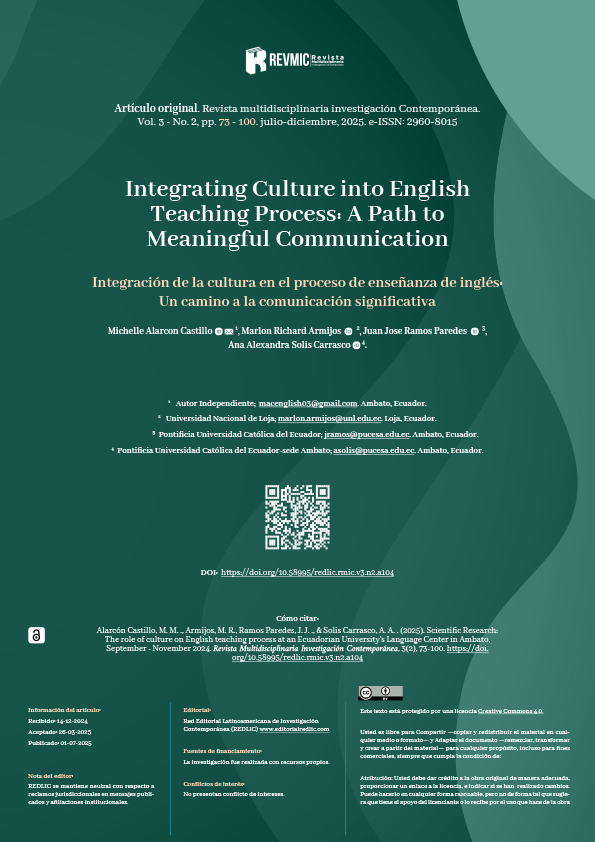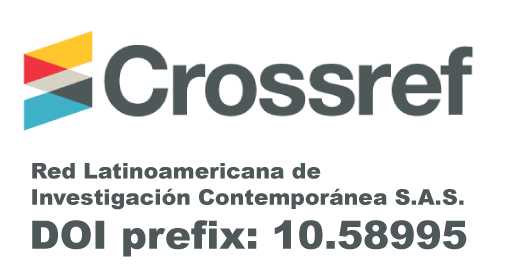Integrating Culture into EnglishTeaching Process: A Path toMeaningful Communication
Resumen
This study investigates the role of culture in the English teaching process as a path to meaningful communication. The research explains how local cultural elements influence teaching effectiveness of English as a Foreign Language (EFL). Using a descriptive design, a mixed method was employed to gather data through surveys, checklist, and classroom observations fieldnotes. The findings highlight teachers' perceptions of culture as a vital component in language acquisition, as well as explore the effective strategies used to incorporate cultural aspects into teaching practices. Additionally, the study identifies the benefits of cultural integration, such as enhanced student motivation and engagement, alongside challenges, including limited resources and varying levels of teachers’ training. This research offers valuable insights into optimizing cultural integration in EFL classrooms, contributing to a more inclusive and effective teaching-learning process.
Descargas
Referencias
- Ahmed, S. (2017). Impact and implementation of sociocultural theory in ESL classroom. Semantic Scholar Org. https://dspace.bracu.ac.bd/xmlui/bitstream/handle/10361/9048/13303025_ENH.pdf?isAllowed=y&sequence=1
- Aziz, et al. (2020). From pragmatic competence to intercultural competence: Pakistani ESL teachers’ perspectives of teaching interculturality in ESL classroom. Revista Amazonia Investiga. https://doi.org/10.34069/ai/2020.33.09.4 DOI: https://doi.org/10.34069/AI/2020.33.09.4
- Cohen, L., Manion, L., & Morrison, K. (2018). Research methods in education (8th ed.). London: Routledge. https://doi.org/10.4324/9781315456539 DOI: https://doi.org/10.4324/9781315456539
- Chaouche, M. (2017). Incorporating Intercultural Communicative Competence in EFL Classes. SSRN Electronic Journal. https://doi.org/10.2139/ssrn.2895538 DOI: https://doi.org/10.2139/ssrn.2895538
- Choudhury, M. (2018). Teaching Culture in EFL: Implications, Challenges and Strategies. IOSR Journal Of Humanities And Social Science, 13(1), 20-24. https://doi.org/10.9790/0837-1312024 DOI: https://doi.org/10.9790/0837-1312024
- Clouet R. (2017). The Intercultural Dimension of English as an Academic Lingua Franca (EALF) in Scientific Publications. Revista De Lenguas Para Fines Específicos, 23(2-7), 313–333. Recuperado a partir de https://ojsspdc.ulpgc.es/ojs/index.php/LFE/article/view/814 DOI: https://doi.org/10.20420/rlfe.2017.348
- Ertuğruloğlu O. (2024). The Impact of Culture on the Education System - International e-Journal of Educational Studies https://doi.org/10.31458/iejes.1436091 DOI: https://doi.org/10.31458/iejes.1436091
- 8. Fernández-Agüero, M., & Chancay-Cedeño, C. (2018). Interculturality in the Language Class – Teachers’ Intercultural Practices in Ecuador. RELC Journal, 50, 164 - 178. https://doi.org/10.1177/0033688218755847 DOI: https://doi.org/10.1177/0033688218755847
- 9. Freedman et al. (2016). Collaboration in Visual Culture Learning Communities: Towards a Synergy of Individual and Collective Creative Practice - International Journal of Art & Design Education - https://onlinelibrary.wiley.com/doi/10.1111/jade.12099
- Heidari, A., Ketabi, S., & Zonoobi, R. (2014). The Role of Culture Through the Eyes of Different Approaches to and Methods of Foreign Language Teaching. Journal of Intercultural Communication, 14(1), 1–15. https://doi.org/10.36923/jicc.v14i1.667 DOI: https://doi.org/10.36923/jicc.v14i1.667
- McKay, S. L. (2018). English As an International Language: What It Is and What It Means For Pedagogy. RELC Journal, 49(1), 9-23. https://doi.org/10.1177/0033688217738817 DOI: https://doi.org/10.1177/0033688217738817
- Ministerio de Educación del Ecuador - Consejo de Educación Superior (2022). https://www.ces.gob.ec/wp-content/uploads/2022/08/Reglamento-de-Re%CC%81gimen-Acade%CC%81mico-vigente-a-partir-del-16-de-septiembre-de-2022.pdf
- Putry, A. R. A., Astuti, P., & Sakhiyya, Z. (2022). The Manifestation of EFL Teachers’ Self-Efficacy and TPACK with their Teaching Performance. English Education Journal, 12(2), 151-161. https://doi.org/10.15294/eej.v12i2.55567 DOI: https://doi.org/10.15294/eej.v12i2.55567
- Rohmani, L. A., & Andriyanti, E. (2022). Culture teaching in EFL classes: Teachers’ beliefs, attitudes, and classroom practices. Deleted Journal, 9(1), 237-257. https://doi.org/10.24815/siele.v9i1.21834 DOI: https://doi.org/10.24815/siele.v9i1.21834
- Ruggiero, D. (2015). Más allá del fútbol: Teaching Highland Afro-Ecuadorian Culture and Engaging Race and Racism through Documentary Film. Hispania, 98, 594 - 606. https://doi.org/10.1353/HPN.2015.0072 DOI: https://doi.org/10.1353/hpn.2015.0072
- Sariyildiz G. , (2017). TEACHERS' PERCEPTIONS OF THE ROLE OF CULTURE TEACHING IN ELT AND THEIR FAMILIARITY WITH THE TARGET CULTURE. International Journal of Language Academy, 2017, Vol 5, p226 10.18033/ijla.3649 - https://openurl.ebsco.com/EPDB%3Agcd%3A10%3A23217722/detailv2?bquery=10.18033/ijla.3649&page=1 DOI: https://doi.org/10.18033/ijla.3649
- Shrestha K. (2016). Role of (Local) Culture in English Language Teaching - Culture and Language page 2. - Journal of NELTA, Vol 21 No. 1-2, https://typeset.io/pdf/role-of-local-culture-in-english-language-teaching-2sxsk5xhc1.pdf DOI: https://doi.org/10.3126/nelta.v21i1-2.20201
- United Nations UN - Sustainable Goals of the UN - https://sdgs.un.org/goals
- Universidad Nacional de Loja (UNL, 2021) - Líneas de Investigación de la Facultad de Educación de UNL - Capítulo 5 - https://www.unl.edu.ec/investigacion/lineas-investigacion
- Yaman, I. (2017) THE ROLE OF CULTURE IN ENGLISH LANGUAGE TEACHING - IX. International Congress of Educational Research 2017 Ordu https://www.researchgate.net/publication/322078287_THE_ROLE_OF_CULTURE_IN_ENGLISH_LANGUAGE_TEACHING

Publicado 2025-03-28
Palabras clave
- elementos culturales,
- percepción,
- formación,
- integración cultural
Número
Sección
Derechos de autor 2025 Los autores que publiquen en la revista Multidisciplinaria Investigación Contemporánea aceptan los siguientes términos: 1. Los autores mantienen sus derechos de autor (copyright) y otorgan a la revista Multidisciplinaria Investigación Contemporánea el derecho de la primera publicación de su trabajo, bajo una licencia Creative Commons Attribution 4.0. Esta licencia permite que terceros utilicen el contenido publicado, siempre que se mencione la autoría y la primera publicación en esta revista. 2. Los autores pueden establecer acuerdos adicionales para la distribución no exclusiva de la versión publicada de su artículo en otros lugares, como repositorios institucionales, siempre y cuando se indique claramente que el trabajo fue publicado por primera vez en esta revista. 3. Los autores conservan sus derechos de autor (copyright) y garantizan a la revista Multidisciplinaria Investigación Contemporánea el derecho a publicar el manuscrito a través de los canales que considere apropiados. 4. Se permite y se recomienda a los autores compartir su trabajo en línea (por ejemplo, en repositorios institucionales o páginas web personales), una vez que el manuscrito haya sido aceptado para su publicación. Esto puede conducir a intercambios productivos y a una mayor y más rápida citación del trabajo publicado.

Esta obra está bajo una licencia internacional Creative Commons Atribución 4.0.



















